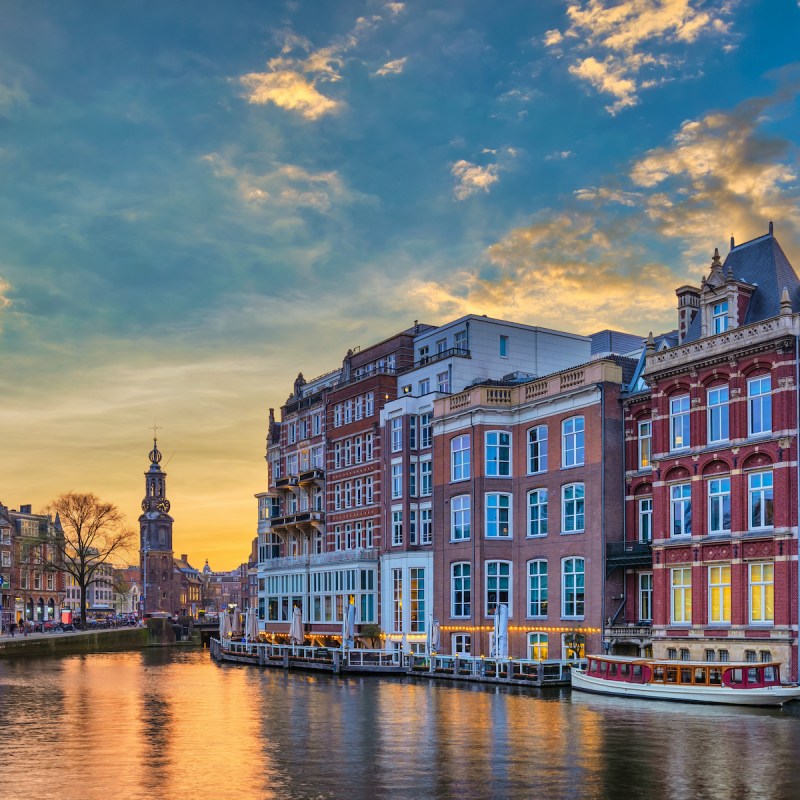
Are you planning that dream European trip? What are the best things to do in Europe, those “once in a lifetime” things, to add to your bucket list? Everywhere you turn in Europe, there is something awesome to enjoy. From famous cities to beautiful villages, cultural attractions, museums, galleries, fabulous food, and fantastic scenery. What are the best things to do in Europe, if you could pick just a few?
Videos by TravelAwaits
Here are my top suggestions — some may be a little unexpected or unusual, but I firmly believe each of these activities deserves its place on my list of unforgettable things to do in Europe.

1. Eat On An Island Near Amsterdam
Eating at Vuurtoreneiland is no ordinary night out in Amsterdam. This is almost an adventurous mini-vacation! If you’re after a once-in-a-lifetime dinner experience, nothing comes close to Lighthouse Island. The island experience starts at the Lloyd Hotel, from where you sail on the historic IJveer XIII across to the small rugged island of Vuurtoreneiland, with just a lighthouse, an old abandoned fort, and a large greenhouse dining room.
The table d’hôte menu is prepared with regional products and old-fashioned cooking techniques. The ethos here is “eating in and from nature,” and a five-course set menu of the freshest regional produce is prepared and cooked entirely on open flames. The food is fantastic and the setting is glorious. During spring and summer, people eat in the summer restaurant, a transparent glass greenhouse, sheltered from wind and rain. In the colder months, dining is done in the winter restaurant, a more intimate and warm experience (with a fire and a blanket).
Vuurtoreneiland can only be reached by ship. The boat trip there and back, including dinner, takes about 5 hours.
Pro Tip: For reservations, use the online reservation portal, and I’d recommend booking at least 2 months in advance. In total, you will be looking at around $100, including the return boat trip, six-course menu, and the fee for contribution to monument maintenance. Add another $45 for wine pairings for your meal (non-alcoholic options are also available).

2. Bike Amsterdam’s Canals
While we’re in Amsterdam, let’s work off our delicious dinner at Vuurtoreneiland with a little exercise. This really is a city on two wheels and for residents, getting around by bicycle is a way of life. There aren’t many capital cities in Europe where you can just rent a bike and ride. Cycle along the famous canals like the Prinsengracht and catch a glimpse of the 17th-century canal houses or ride through Vondelpark, which is particularly beautiful in spring and fall. On two wheels, you’ll not only feel like a local, but you’ll also cover much more ground.
Pro Tip: Don’t forget to use hand signals when turning and don’t stop in the middle of the bike lanes, no matter how photographic the scenery is! If you forget, the locals will quickly remind you of the rules!

3. Walk On London’s Primrose Hill
London is famous for its parks. However, there’s something extra special about a stroll on Primrose Hill. It has a character all of its own and at the summit of this grassy hill are some spectacular views across London. The summit is almost 210 feet above sea level and the trees are kept low so they do not obscure the view.
On the way up, look out for an oak tree known as “Shakespeare’s Tree” first planted in 1864 to mark the 300th anniversary of Shakespeare’s birth. A large crowd of workmen marched through London to watch the planting ceremony. A replacement tree was re-planted in 1964.
Pro Tip: Time your walk for sunset and watch the sky glow orange over landmarks like Canary Wharf, the Millennium Wheel, and St. Paul’s Cathedral in the distance.

4. Enjoy Pintxos In San Sebastián
Spain’s San Sebastián (or Donostia to the local Basque people), is known for its excellent cuisine. Home to countless Michelin-starred restaurants, pintxo bars, food markets, and gourmet food shops, San Sebastián is often called the food capital of the world. Basque-style tapas are known as pintxos and are usually small pieces of bread, topped with a variety of ingredients.
These include anything from Spanish ham, fresh seafood, prawns, and anchovies, to cheese, chorizo, and wild mushroom croquettes. They’re usually speared with sticks and placed along the bar to accompany your drink. At the end of the night, your sticks are counted and you pay your bill. San Sebastián is the king of this style of eating.
Pro Tip: Gorriti Taberna is one of the best pintxos bars in town. It has an authentic neighborhood feel. Open from 7 a.m. to 10 p.m., Monday to Saturday, you should expect to spend about $2-3 per pintxo.

5. Walk In The Foothills Of The Italian Dolomites
The Italian Dolomites, a mountain range located in northeastern Italy, are one of Europe’s most beautiful alpine regions. In the winter months, they are a snowy winter wonderland, renowned for skiing. In summer, they are a mecca for mountain climbing and hiking.
The best months of the year to visit are from late spring and early summer (May-June) when the sun is shining but the temperature is cool enough that you can hike through the Dolomites comfortably, plus there are fewer tourists!
Pro Tip: Hiking trails here open mid-to-late May after the snow has melted. While self-guided hiking is entirely possible, 57 Hours offers a variety of guided hikes in the Dolomites, if you’d rather not go it alone.

6. Body Scrub At A Hammam In Istanbul
A traditional Turkish hammam (public steam bath) is an unmissable experience for anyone visiting Istanbul. A “bath package” usually includes traditional body scrubbing with a handwoven wash cloth known as a kese, then a foam wash, followed by a massage. There’s no better hammam to visit in Istanbul than Kılıc Ali Pasa Hamam, an architectural masterpiece, the work of renowned Ottoman architect Mimar Sinan that dates back half a millennium.
The hammam was constructed between 1578 and 1583, to serve the forces of the Ottoman navy, reopening to the public in 2012, after a major restoration. Famous for its architectural lines and majestic dome, the Kılıc Ali Pasa Hamam is one of the most striking buildings in Tophane, Istanbul’s harbor district.
Pro Tip: The hammam is open to women in the morning and men in the afternoons. Visitors are provided with a peshtemal, a thin cotton towel to wrap themselves in, and a regular towel to use after bathing

7. One Of Europe’s Oldest Flea Markets In Barcelona
With a distinctive, undulating, reflective roof, designed by renowned architect Fermín Vázquez, Mercat dels Encants, dating back to around 1300, is Barcelona’s largest and best-known flea market. It is also one of Europe’s oldest. With 301 shops and nine restaurants, there’s a seemingly endless number of vendors to visit.
Take your time to explore what’s on offer. You’ll find everything from knick-knacks to gems like vintage furniture, clothes, and books. The furniture in the big hall, to the side of the market, is incredible and well worth a look. Saturday is the busiest day, so avoid it if you’re just a casual browser, and if you’re looking for real bargains, arrive early.
Pro Tip: Open hours are Monday, Wednesday, Friday, and Saturday, 9 a.m. to 8 p.m. Antique auctions take place Mondays, Wednesdays, and Fridays from 7 to 9 a.m., when the commercial buyers are there, and again at noon when the unsold goods drop in price. The market is meant to carry on until the afternoon but most stalls tend to pack up at midday.

8. Drive The Wild Atlantic Way In Ireland
A road trip that certainly deserves a place on your bucket list is Ireland’s Wild Atlantic Way. Driving from Malin Head in the north to Mizenhead in the south is an epic and beautiful drive along some of the most spectacular coastlines in the country.
It’s not a short route at 1,550 miles, but it’s worth it. Check out the Giant’s Causeway and The Dark Hedges in County Antrim, and Ballynahinch Castle in Galway, one of Ireland’s finest luxury castle hotels. Pull over to eat at Wild Honey Inn in County Clare, Ireland’s only Michelin-starred pub, located in a lovingly restored 19th-century inn, in the Burren National Park. There are some great beaches along the way, like Lough Swilly beach near Rathmullan House in Donegal, and Gurteen Beach in Connemara.
Pro Tip: If you take this route, you’ll also tick off the Ring of Kerry, the picturesque villages of Kenmare & Sneem, the Lakes of Killarney, and The Skellig Islands, which are one of the biggest draws of the Wild Atlantic Way.
9. Culinary Hike In The Austrian Mountains
If you’ve never heard of Vorarlberg, here’s one great reason why it should be on your European bucket list. Austria’s westernmost province offers its visitors the opportunity to combine hiking, in this picturesque location, with enjoying deliciously prepared dishes, in excellent restaurants, rustic inns, or local cheese cellars. The average walking time on the numerous routes is 3-5 hours, depending on which route you choose.
However, along the way, you get the chance to take a break and sample traditional Austrian food. On a typical day tour, you walk from breakfast to lunch and then on to dessert. Each course is served at a different Alpe (hut), mountain top inn, or restaurant, and the food definitely gives you the incentive to continue, and breaks up what is quite a workout! You can visit the Voralberg Culinary Hikes website to choose the route that appeals to you.

10. Prague’s Christmas Markets
There’s never a bad time of year to visit Prague — rain, hail, or shine, the city is so charming that the weather is just a backdrop. That being said, perhaps there is no better time of year to visit Prague than December. Christmas markets are wonderfully kitsch and “in-your-face-festive,” and nowhere seems to do them quite as well as Prague.
In the icy evenings, Old Town Square is illuminated with sparkling lights and an impossibly big, heavily adorned tree. The city comes to life with endless Christmas markets, street food, decorations, and of course, warming glühwein at stalls right in front of the medieval Prague Astronomical Clock. If you’re planning a winter escape in Europe, be sure to add Prague to your adventures.
Pro Tip: When your shopping is done, grab a drink at The American Bar in the basement of Tretter’s Municipal House. This is the oldest bar in Prague and the second oldest bar in Europe. Alternatively, try the hole-in-the-wall absinthe bar, Green Devil’s, which offers more than 100 absinthes from around the world, and whose doorway glows green, like a witch’s cauldron.
I hope these suggestions will come in handy when you are planning your next European vacation.

